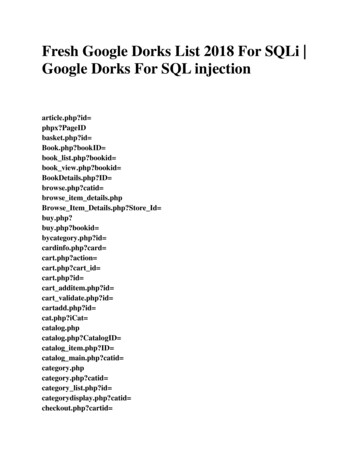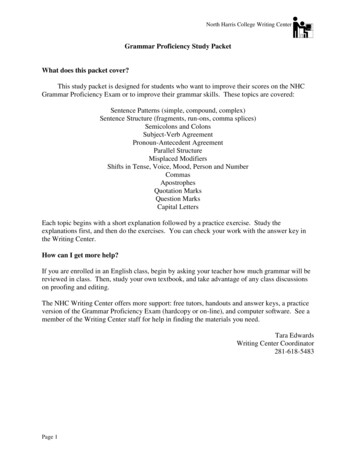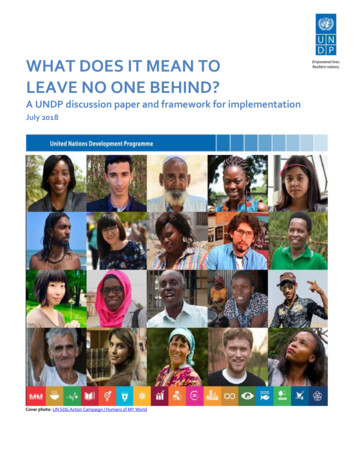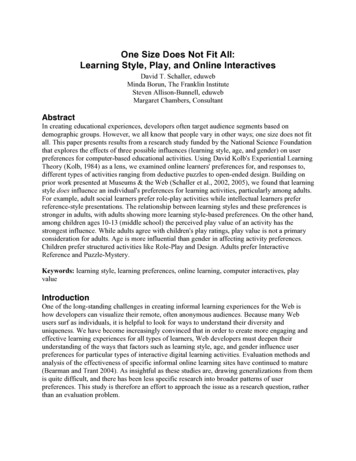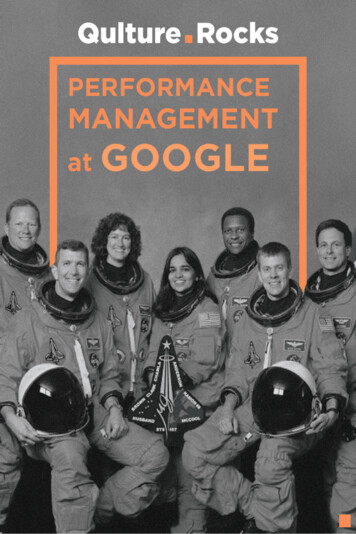
Transcription
Case Study: How Google doesPerformance ReviewsEverything you need to know aboutGoogle’s performance managementpracticesFrancisco S. homem de Mello 2016 Francisco S. homem de Mello
ContentsIntroduction . . . . . . . . . . . . . . . . . . . . . . . . . .1Where did we take all this stuff from? . . . . . . . . . . .3Overview . . . . . . . . . . . . . . . . . . . . . . . . . . . .4Performance Reviews . .Self-Evaluation . . .360-degree FeedbackCalibration . . . . . .Outputs . . . . . . .56678OKRs . . . . . . . . . . . . . . .TL;DR . . . . . . . . . . . .Introduction . . . . . . . . .A Brief History of OKRs . .A bit of goal-setting science.1212131417
Introduction”We need people to know how they’re doing, and we’ve evolved whatmight at first seem like a zanily comples system that shows themwhere they stand. Along the way, we learned some startling stuff.We’re still working on it, as you’ll see, but I feel pretty confidentwe’re headed in the right direction. And with any luck I can saveyou some of the headaches and missteps we had along the way.” Laszlo Bock, SVP, People Operations, GoogleGoogle has probably Silicon Valley’s, and maybe the world’s, mostadvanced human resources (or, as they call it, People Operations)practice. As it becomes clear by books like Work Rules, written by itsSVP of People Operations, and How Google Works, by Eric Schmidt,its former CEO, and Jonathan Rosenberg, current SVP of Product,the company continuously iterates on people practices, based onuniquely huge amounts of data, gathered among its more than 50thousand “smart creatives”, employees in the fields of engineering,design, and sales, all handpicked at the world’s top universities.Google’s people operations cornerstones are: Hiring only the best: sourcing, and selecting, only the best fitcandidates amongst the best pool of candidates worldwide,and, if it can’t reasonably achieve 100% perfection in hiringonly amazing fits, skewing errors towards false negatives(eventually passing on a great candidate) instead of falsepositives (eventually hiring a bad fit); Creating a meritocratic environment, where the best performances are correctly identified and rewarded; and,1
Introduction2 Developing employees to their full potential, through greatpeople management and on-the-job coaching (see our ProjectOxygen paper here), peer-to-peer and outside training, andthrough a comprehensive 360-degree feedback collection process;The purpose of this case is to explain a bit better, and in detail,how Google does the second bullet point, meritocracy, and bitsof the third, development, through its performance managementprocedures.But why, you may ask, look at Google for a benchmark? Apartfrom the obvious reasons (it seems to be working for them, eh?),it our view that smaller, less resourceful companies (and herewe’re talking more about sheer cash and headcount, as opposedto attitude), can greatly benefit from using Google as a startingpoint for their own practices, and then iterating on that (what iscommonly known as standing on the shoulders of giants). Whyshould you, HR manager, or C-level executive, reinvent the wheelwhen this giant company has not only spent millions and millions ofdollars finding its best self, but talked at length about it, so that youcan benchmark yourself and use many of these practices? There’reno good reasons not to[1].We’ll have achieved our goals if you find some inspiration and bestpractices on this paper. Remember we, at Qulture.Rocks, can helpyou get your performance management practices (be them inspiredby Google or not) running in a matter of hours.
Where did we take all thisstuff from?Great question! Google, as many of the world’s top companies (likeGE, AB InBev, Walmart, etc), talks frequently and openly about itsown culture. So we basically read everything that’s out there – andactually written by Google and its current and former employees-. We’ve also scanned online platforms like Quora, Medium, andTwitter, read many pieces by the press, and, finally, interviewed asmany as 10 former executives, both from People Operations andfrom areas like Search and Google Ventures, in order to form aholistic understanding of Google’s practices.We’re confident that you have a very faithful description in yourhands. Some of the processes may have already been iterated outactivity, but for the most part, we strongly believe you have anaccurate picture of the company’s current practices.3
OverviewFor the purposes of this case study, we’re calling performancemanagement the collection of the following human resources toolsand processes used at Google: Annual performance review (including mid-year checkpoint) Monthly performance check-ins (part of regular 1:1 meetingsthat also comprise other themes such as career development,coaching, personal issues, etc. Googlegeist engagement survey (that spans much more thanjust the regular engagement axes, but measures basicallyeverything that’s to be measured) Annual Upward Feedback Survey, a feedback review (similarto 360-degree review) where only supervisors are reviewedby their direct reports, and that is based on Google’s ProjectOxygen OKRs, or objectives and key-results, a mildly different formof Management-by-Objectives, that we explain in this post,and Meritocracy, or compensating people unequally, based ontheir perceived performance, through bonuses, equity stockoption grants, and prizes Performance reviews4
Performance ReviewsGoogle’s annual performance review cycle is comprised of twoparts: a “preview”, in the end of the first semester, and a completereview, that happens between October and November, and whichhappens concurrently with the company’s 360-degree feedbackcollection process.Managers take two main things into account when attributingtheir employees’ performance ratings: results attained, or whatthe employee accomplished, and behaviors, or how the employeeattained these results. The employee starts with a self-assessment,which is followed by peer-reviews, whose authors are only visibleto managers (reviewees may have access to the anonymized contentof peer reviews).On the review side, Google employees are asked to review eachother, and their direct reports, according to the following criteria: Googleyness: The employee’s adherence to Google’s values.This is the main component of the “how” axis. Problem solving: Analytical skills applied to work situations(problem solving). Execution (high quality work with little guidance): Delivering great work without the need for a lot of hand-holdingfrom managers and peers (autonomy). Thought leadership: How much an employee is seen as areference for a given niche of expertise. As Google grows insize, these niches may tend to become smaller and smaller,but still, Google wants employees that are go-to resourcesfor specific themes, training colleagues on tech-talks, traningcustomers, and producing high-quality content.5
6Performance Reviews Leadership (or emerging leadership): Albeit many youngGooglers have little or no exposure to managing complexteams, everybody is required, nonetheless, to show emergingleadership skills, such as taking the lead of problems andprojects, being pro-active, and owning results personally. Presence: Presence is the employee’s ability to make himselfheard in an increasingly large organization, and intimatelyrelated to emerging leadership.Self-EvaluationThe self-evaluation is the first step in the performance review, andwhere the employee evaluates himself in the five criteria describedabove (on five grades ranging from “never demonstrates” all theway to “always demonstrates” and invited to share examples ofhis actions that support these grades), and highlights his mainaccomplishments for the last cycle (in a text field limited to 512characters). These accomplishments will appear in the next step(360-degree reviews) to reviewing peers, who’ll be then askedto assess their proximity with these projects, and the reviewee’simpact on their results.360-degree FeedbackGoogle’s 360-degree review process serves the purpose of givingmanagers a holistic picture of their direct reports, since they maycarry a biased and restricted impression of reports’ impact andbehavior (some employees may be great at “managing up” a rosypicture of their contributions, for example).The process starts with a back-and-forth between employee andmanager, so as to pick a representative, fair sample of peers toparticipate. The employee suggests a shortlist, that is discussed and
7Performance Reviewsvalidated with the manager, taking into account how close the peerwas to the employee’s contributions, and how well she can assessthe employee’s performance.Peers are expected to give assessments in three different media:strengths, or things that the person should keep on doing, andweaknesses, or things that the person should consider workingon/developing; rating each other on the five criteria discussedabove; and finally, commenting on the reviewee’s contributionto specific projects. These two open-ended fields (positives andnegatives) have evolved from a larger form a few years ago. LaszloBock, Google’s SVP, People Operations, observes in his Work Rulesthat the simplification reduced aggregate time spent on this stepby more than 25%, while improving the share of participants whoperceived it as useful from 49% to 75%.CalibrationAfter all data has been collected, in the form of self-reviews andpeer-reviews (or what’s known as 360-degree feedback), and resultsachieved are understood, managers draft a rating for their employees, based on the following scale[2]: Needs improvementConsistently meets expectationsExceeds expectationsStrongly exceeds expectationsSuperbAs you may have noticed, I said they draft their ratings. That’sbecause no ratings are final before the calibration process, again,described by Laszlo Bock:“The soul of performance assessment is calibration A managerassigns a draft rating to an employee – say, ‘exceeds expectations’-
8Performance Reviewsbased on mainly OKRs but tempered by other activities, like thevolume of interviews completed, or extenuating circumstances suchas a shift in the economy that might have affected ad revenues.Before his draft rating becomes final, groups of managers sit downtogether and review all of their employees’ draft ratings together ina process we call calibration A group of five to ten managers meetand project on a wall their fifty to a Thousand employees, discussindividuals, and agree on a fair rating. This allows us to removethe pressure managers may feel from employees to inflate ratings.It also ensures that the end results reflect a shared expectationof performance, since managers often have different expectationsfor their people and interpret performance standards in their ownidiosyncratic manner Calibration diminishes bias by forcing managers to justify their decisions too ne another. It also increasesperceptions of fairness among employees.”Calibration, a process also adopted at other leading companies suchas AB InBev, GE, Kraft Heinz, and Goldman Sachs, is therefore ofcrucial importance in ensuring the fairness of performance ratings.It’s where heavy-handed raters are identified and discounted for(and the opposite is also true).OutputsThe calibration meetings output each and every employee’s performance rating for the period. After the rating is closed, managers goon to hold two meetings: one where feedback is given, taking intoaccount peer reviews and managers’ impressions of their employees, and another where compensation and promotion decisions arecommunicated.The two conversations are held in different meetings and at least amonth apart from each other in order to ensure their quality. Googleunderstands that a compensation-focused employee is no good alistener of feedback, whether compensation expectations were not
Performance Reviews9met, met, or exceeded:“a [negative] dynamics exists when managers sit down to giveemployees their anual review and salary increase. The employeesfocus on the extrinsic reward – a raise, higher rating – and learningshuts down . We have an embarassingly simple solution. Neverhave the [pay and feedback] conversations at the same time. Annualreviews happen in November, and pay discussions happen a monthlater.”The theme is also discussed by Prasad Setty, member of Google’sPeople & Innovation Lab[3]:“Traditional performance management systems make a big mistake.They combine two things that should be completely separate: performance evaluation and people development. Evaluation is necessaryto distribute finite resources, like salary increases or bônus dollars.Development is just as necessary for so people grow and improve.”
Performance Reviews10Diagram 1: Google’s simplified performance management schedule[1] Actually there is one good reason not to: You’re in a businesswhere the majority of your employees are not “smart creatives,”but maybe less educated, operational, hourly workers, maybe not ascapable of self-management, and maybe not as high on Maslow’spyramid. Valid argument, but we won’t discuss it in detail here.Enough to say that you’ll have much more to gain from learningwith Google than ignoring it, for now.[2] Before a five-point scale, Google rated its employees on a scalefrom 1 to 5 in 0,1 increments, having, in fact, 40 possible ratings.The scale, according to Laszlo Bock, beared many inneficiencies, aswas ditched after more than 10 years in use for a simpler scale.[3] Google’s People & Innovation Lab, or PiLab, is worth a bookitself. In short, it’s a team of quants whose only attribution isto study people data (performance, engagement, happiness, etc),
Performance Reviews11iterate on people practices (testing them), and to contin
Oxygen rm , and Meritocracy, or compensating people unequally, based on ck-optiongrants,andprizesPerformancereviews 4. PerformanceReviews Google’s annual performance review cycle is comprised of two parts:a“preview .
